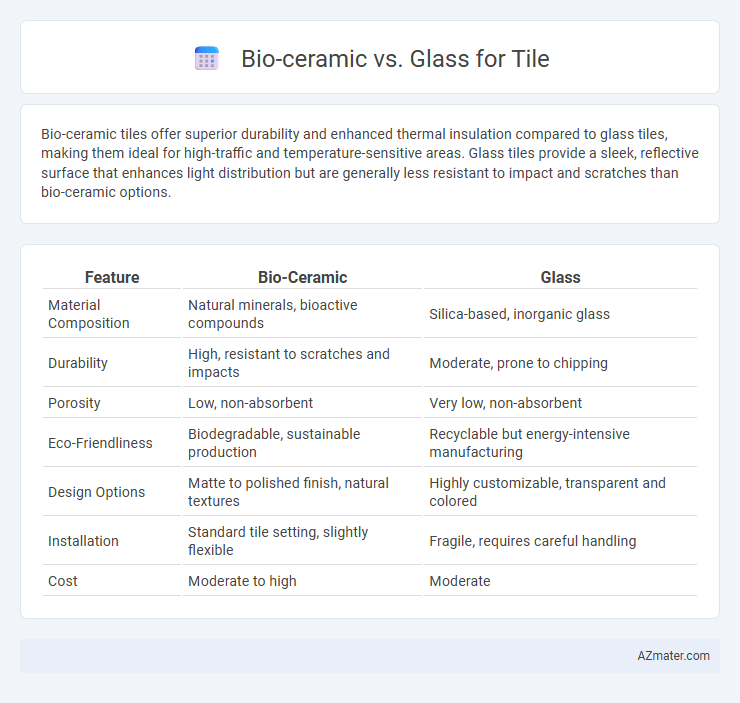Bio-ceramic tiles offer superior durability and enhanced thermal insulation compared to glass tiles, making them ideal for high-traffic and temperature-sensitive areas. Glass tiles provide a sleek, reflective surface that enhances light distribution but are generally less resistant to impact and scratches than bio-ceramic options.
Table of Comparison
| Feature | Bio-Ceramic | Glass |
|---|---|---|
| Material Composition | Natural minerals, bioactive compounds | Silica-based, inorganic glass |
| Durability | High, resistant to scratches and impacts | Moderate, prone to chipping |
| Porosity | Low, non-absorbent | Very low, non-absorbent |
| Eco-Friendliness | Biodegradable, sustainable production | Recyclable but energy-intensive manufacturing |
| Design Options | Matte to polished finish, natural textures | Highly customizable, transparent and colored |
| Installation | Standard tile setting, slightly flexible | Fragile, requires careful handling |
| Cost | Moderate to high | Moderate |
Introduction to Bio-Ceramic and Glass Tiles
Bio-ceramic tiles, composed of natural clay mixed with other inorganic materials and fired at high temperatures, offer exceptional durability, resistance to wear, and eco-friendly properties. Glass tiles, made from thin, recyclable glass pieces, provide a glossy, reflective surface ideal for decorative applications and moisture-prone areas due to their non-porous nature. Both materials serve unique aesthetic and functional purposes, with bio-ceramic emphasizing strength and sustainability while glass tiles excel in light transmission and vibrant color options.
Material Composition: Bio-Ceramic vs Glass
Bio-ceramic tiles are composed primarily of natural clays and minerals fused at high temperatures, resulting in a dense, durable material with enhanced thermal insulation and resistance to chemicals. Glass tiles consist mainly of silica-based glass, often recycled, offering superior water resistance and a smooth, reflective surface but tend to be more fragile under impact. The inherent differences in material composition influence their suitability for various applications, with bio-ceramics favoring durability and thermal performance, while glass excels in aesthetic appeal and moisture impermeability.
Aesthetic Appeal and Design Flexibility
Bio-ceramic tiles offer a superior aesthetic appeal with their natural, earthy textures and muted tones that create a warm, organic ambiance, contrasting with the sleek, reflective surfaces of glass tiles that provide a modern, high-gloss finish ideal for contemporary designs. Design flexibility is enhanced in bio-ceramic options due to their varied finishes, including matte, satin, and textured patterns, allowing for versatile applications in rustic or minimalist interiors, while glass tiles excel in customization with vibrant colors, translucency, and mosaics that brighten spaces and emphasize light interplay. Both materials support diverse design intents, but bio-ceramic emphasizes subtlety and natural beauty, whereas glass prioritizes brightness and bold, dynamic aesthetics.
Durability and Resistance to Wear
Bio-ceramic tiles offer superior durability and resistance to wear due to their dense molecular structure, making them highly resistant to scratches, stains, and chipping. Glass tiles, while aesthetically appealing and resistant to moisture, tend to be more prone to cracking and surface damage under heavy impact or abrasive conditions. The enhanced hardness of bio-ceramic materials ensures longer-lasting performance in high-traffic or demanding environments compared to the relatively fragile nature of glass tiles.
Installation Process and Requirements
Bio-ceramic tiles offer a lighter weight and easier cutting process compared to glass tiles, which reduces installation time and labor costs. Glass tiles require meticulous surface preparation and specialized adhesives to ensure proper adhesion and prevent cracking. Both materials demand skilled installers, but bio-ceramic tiles are generally more forgiving in alignment and grout application, simplifying the overall installation procedure.
Maintenance and Cleaning Considerations
Bio-ceramic tiles feature a non-porous surface that resists stains and requires minimal maintenance, making cleaning effortless with just mild soap and water. In contrast, glass tiles are also non-porous but can show water spots and fingerprints more prominently, necessitating frequent wiping to maintain their glossy finish. Both materials benefit from avoiding abrasive cleaners that could damage their surfaces, but bio-ceramics offer superior durability against scratches and chemicals during regular cleaning routines.
Environmental Impact and Sustainability
Bio-ceramic tiles are often more sustainable than glass tiles due to their lower energy consumption during production and the use of natural raw materials like clay and minerals. Glass tile manufacturing involves high temperatures to melt silica, resulting in higher carbon emissions compared to the firing process of bio-ceramics. Additionally, bio-ceramic tiles have better recyclability and biodegradability, contributing to reduced environmental impact and enhanced sustainability in construction projects.
Cost Comparison: Bio-Ceramic vs Glass Tiles
Bio-ceramic tiles generally cost more than glass tiles due to their advanced manufacturing process and enhanced durability. Glass tiles offer a budget-friendly option with a wide range of aesthetic finishes, though they may be more prone to chipping and require careful installation. Investment in bio-ceramic tiles can result in higher long-term value because of their superior scratch resistance and longevity compared to glass counterparts.
Best Applications for Each Tile Type
Bio-ceramic tiles offer superior durability and resistance to abrasion, making them ideal for high-traffic areas like commercial spaces, kitchens, and bathrooms where long-lasting performance is essential. Glass tiles provide a sleek, reflective surface that excels in decorative applications such as backsplashes, feature walls, and accent trims, enhancing light and visual appeal in residential and hospitality settings. Both materials demonstrate excellent moisture resistance, but bio-ceramic is preferred for heavy-duty flooring, while glass is favored for aesthetic enhancements and low-traffic surfaces.
Choosing the Right Tile for Your Project
Bio-ceramic tiles offer superior durability and eco-friendly properties compared to glass tiles, making them ideal for high-traffic areas and sustainable projects. Glass tiles provide a sleek, modern aesthetic with excellent light-reflective qualities, perfect for accent walls or decorative backsplashes. Selecting the right tile depends on project needs such as durability, maintenance, design preference, and environmental impact.

Infographic: Bio-ceramic vs Glass for Tile
 azmater.com
azmater.com